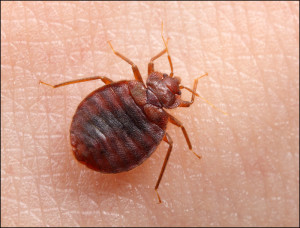 A bed bug infestation usually starts when you unknowingly bring them into your home. Bed bugs might be transported on luggage or furniture you bought at a garage sale for example, somewhere where there was already an infestation. In the early stages, when bed bugs are only just beginning to establish an infestation, that is when they are at their most vulnerable. If you find the infestation early before it spreads to other areas, you will save yourself a lot of time and money.
A bed bug infestation usually starts when you unknowingly bring them into your home. Bed bugs might be transported on luggage or furniture you bought at a garage sale for example, somewhere where there was already an infestation. In the early stages, when bed bugs are only just beginning to establish an infestation, that is when they are at their most vulnerable. If you find the infestation early before it spreads to other areas, you will save yourself a lot of time and money.
What do Bed Bugs Look Like?
It is important to know what bed bugs look like so you can distinguish them from other insects commonly found indoors. Adult bed bugs are big enough to see with the naked eye and grow to about the size of an apple seed. However, young bed bugs are much smaller and translucent; which means you can only see them when they have recently fed at which point they will be red in colour.
Identify the Signs
As bed bugs tend to hide during the day, spotting one might prove difficult. The most accurate way of finding out if you have bed bugs is to search for the physical clues they leave around the infestation area. Bed Bug Extermination Toronto Recommends Looking for things like:
- Eggs or egg shells. These are about 1 mm but easier to see when in bunches.
- Shed skins, which are pale yellow.
- Small rusty stains on sheets where bed bugs have been crushed.
- Tiny dark spots on sheets indicating bed bug excrement.
- A cluster of bed bugs hiding in a crevice.
If you see anything like the aforementioned clues, you more than likely have a bed bug infestation and should call in the professionals immediately, before they spread.
Bed Bugs Favoured Hiding Places
Bed bugs like the small cracks and crevices in the vicinity of their feeding area, places such as:
- Drawer joints
- The small spaces where screws have been inserted.
- At junctions such as window frame corners and where the wall meets the ceiling.
- Beneath loose wallpaper and pictures or wall hangings etc.
- Inside electrical sockets and even appliances.
- In the folds of curtains, between cushions and the seams of chairs.
If you suspect you have a bed bug infestation, a thorough check of these areas might yield some clues.
Things to Keep in Mind
Bed bugs will quite willingly travel from 5-20 feet to find a meal.
Feed primarily at night but also during the day if still hungry.
They spend 3-12 minutes feeding.
Bed bugs will feed on mammals and birds if there are no humans around.
If you happen upon an infestation, cleaning the area may help to control the bugs in the short term but ultimately in order to ensure all eggs and bed bug young are dealt with, it’s best to use chemical treatments. Remember, whilst you can administer the chemicals yourself, your safest and most effective option is to hire a professional exterminator who knows the ins and outs of the extermination process.